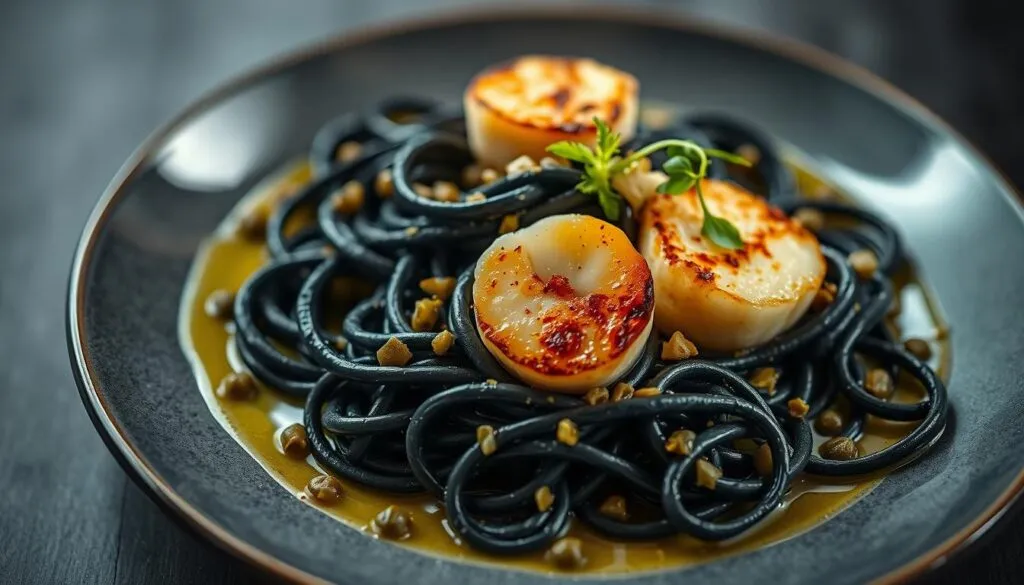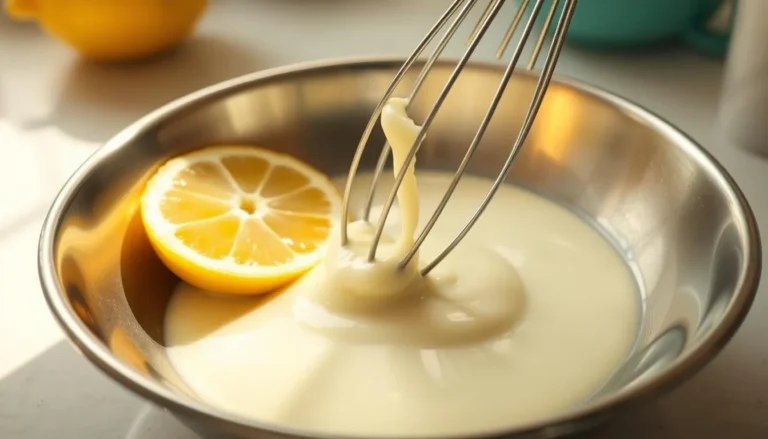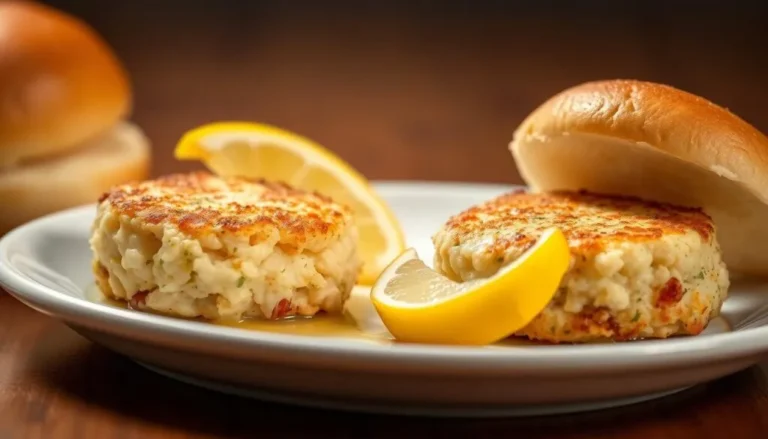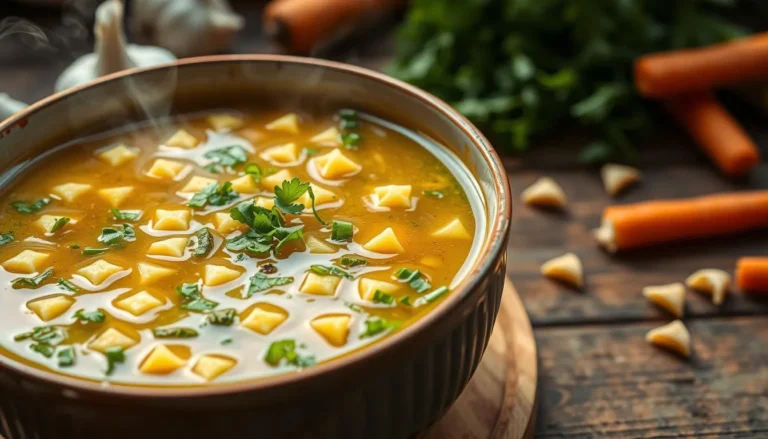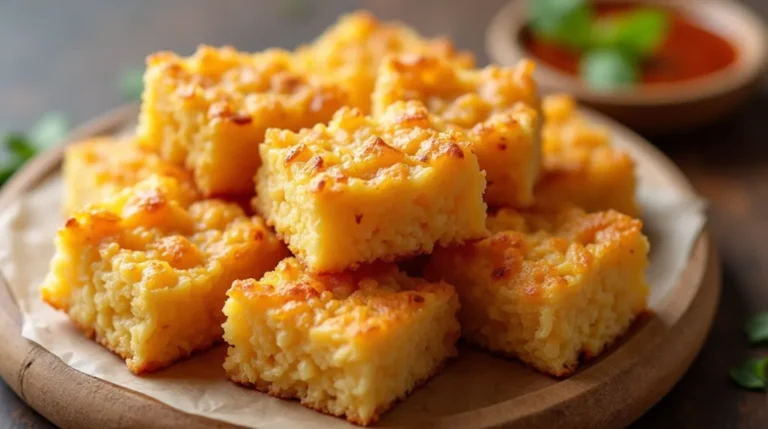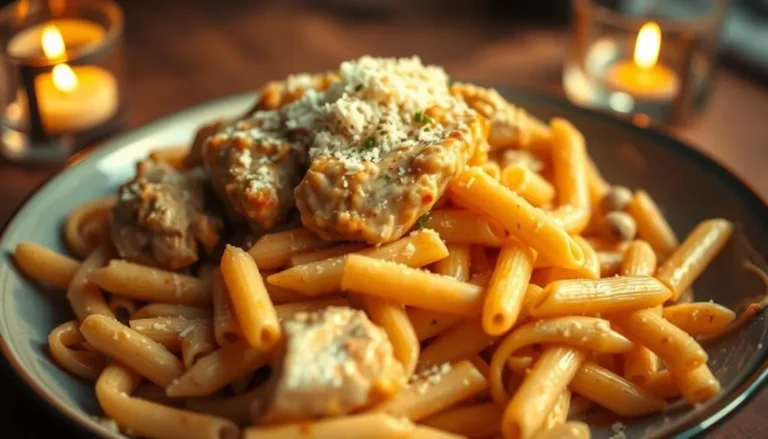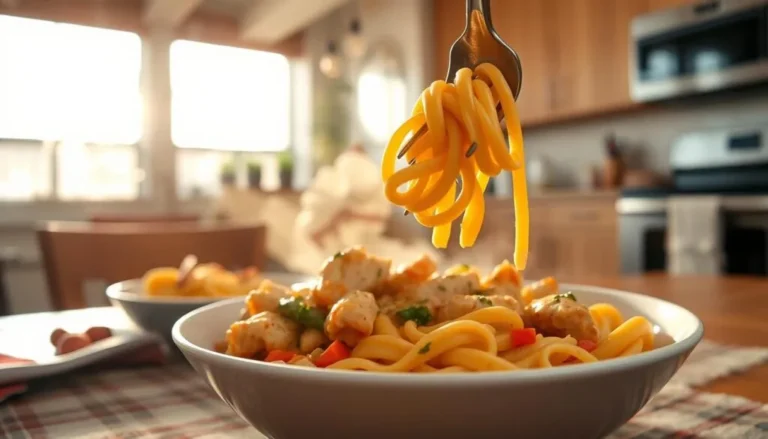Squid Ink Pasta : How to Cook It Like a Pro Chef
Table of Contents
Ever dream of turning a simple dinner into a feast for the eyes and taste? Squid ink pasta is your key. This black pasta is more than just a look—it’s a way to cook like a pro at home.
In coastal Italy and fancy restaurants worldwide, black pasta is a sign of fine dining. Its deep, sea-like taste makes seafood dishes stand out. It’s a sure way to wow your guests.
Whether you’re a beginner or a food enthusiast, learning to make squid ink pasta opens up new culinary possibilities. It’s time to elevate your cooking and amaze your friends with this unique gourmet pasta.
Key Takeaways
- Squid ink pasta offers a unique visual and flavor experience
- Perfect for home cooks wanting to elevate their culinary skills
- Versatile dish that pairs beautifully with seafood
- Requires minimal special techniques to prepare
- Impressive gourmet presentation with simple ingredients
Understanding Squid Ink Pasta
Dive into the fascinating world of cuttlefish ink pasta, a culinary gem deeply rooted in Mediterranean cuisine. This unique ingredient transforms ordinary pasta into an extraordinary gastronomic experience. It captures the essence of coastal cooking.
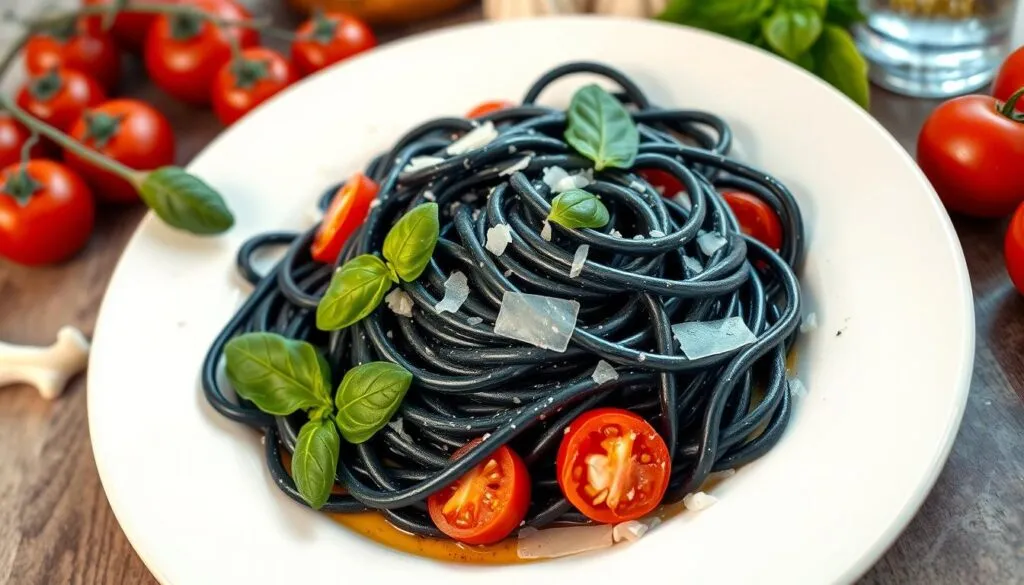
The rich history of squid ink pasta stretches back centuries. Its origins are firmly planted in the vibrant coastal regions of Italy. Chefs and home cooks alike have embraced this distinctive ingredient as a cornerstone of authentic Italian cuisine.
Origin and History
Squid ink pasta emerged as a creative solution for Mediterranean fishermen. Nero di seppia (black of cuttlefish) became a symbol of resourceful cooking. It turns simple ingredients into remarkable dishes.
- Originated in coastal Mediterranean regions
- Developed by fishermen as a way to use entire marine catch
- Deeply integrated into Italian culinary traditions
Nutritional Benefits
The Mediterranean diet celebrates squid ink for its impressive nutritional profile. This dark delicacy packs a powerful punch of health benefits. These benefits extend far beyond its striking appearance.
| Nutritional Component | Value per 100g |
|---|---|
| Protein | 3.5g |
| Antioxidants | High Concentration |
| Calories | Low |
Flavor Profile and Characteristics
“Squid ink transforms ordinary pasta into an extraordinary culinary experience” – Renowned Italian Chef
The flavor of squid ink pasta is distinctively briny and complex. Its smooth, velvety texture brings a unique depth. This is reminiscent of fresh seawater, making it a favorite among adventurous food enthusiasts.
When you cook with squid ink, remember that a little goes a long way. Typically, 1-3 tablespoons per 2 cups of flour creates that perfect dramatic black color. It also brings an intense maritime flavor.
Essential Ingredients for Perfect Squid Ink Pasta
Making great homemade pasta needs the right ingredients and tools. Squid ink pasta is a special tradition that mixes unique tastes with skill.
Fresh vs Store-bought Options
When making seafood pasta, you can choose between two main options for squid ink pasta:
- Fresh homemade pasta with squid ink
- Premium store-bought artisanal pasta
Homemade pasta lets you control what goes into it. You use 1-2 tablespoons of squid ink for every 100 grams of flour. This gives the pasta its black color and deep flavor.
Complementary Ingredients
| Ingredient Category | Recommended Options |
|---|---|
| Seafood | Shrimp, calamari, mussels |
| Aromatics | Garlic, shallots, parsley |
| Liquids | White wine, fish stock |
Required Kitchen Tools
To make perfect seafood pasta, you’ll need these tools:
- Pasta roller or rolling pin
- Large mixing bowl
- Sharp chef’s knife
- Pasta cutter
- Large pot for boiling
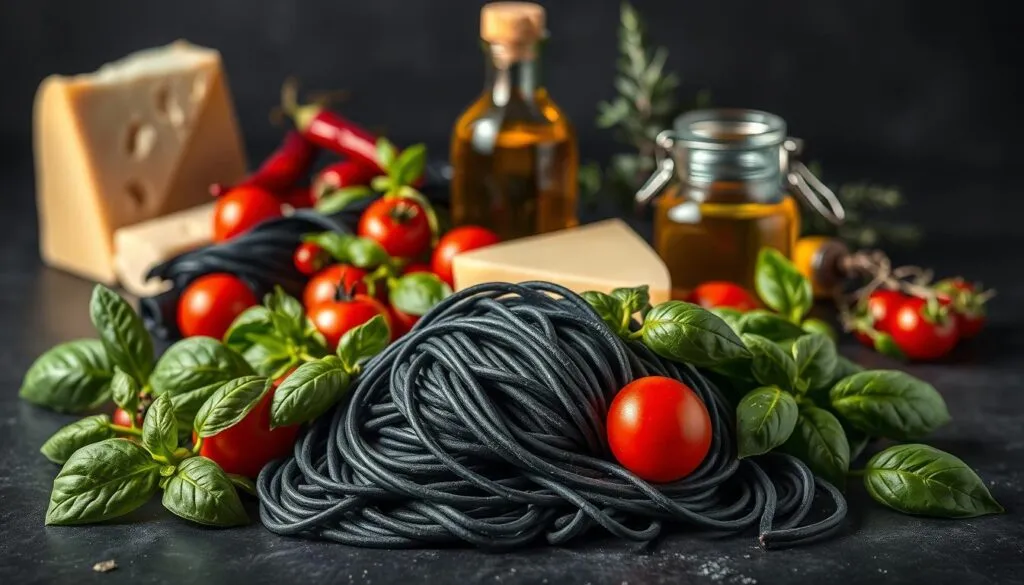
Remember, quality ingredients are key to a great pasta dish. Choosing the best ingredients will make your homemade pasta taste like it’s from a restaurant.
Preparing Your Kitchen for Gourmet Pasta Making
Making homemade pasta is a special task that needs a tidy kitchen. Your kitchen setup is key to making tasty pasta dishes. A well-organized space makes cooking smoother and more enjoyable.
Begin by setting up a clean area for making pasta. Collect all the tools and ingredients you need before starting.
Essential Kitchen Preparation Checklist
- Clear and sanitize your cooking surface
- Arrange tools within easy reach
- Ensure proper lighting
- Protect surfaces from potential staining
Working with squid ink pasta means you need to be careful. Dark pigments can easily stain countertops and clothing. Wear an apron and use dark-colored towels to protect your kitchen and clothes.
Recommended Kitchen Tools
| Tool Category | Specific Items |
|---|---|
| Preparation Tools | Large cutting board, sharp knife, mixing bowls |
| Cooking Equipment | Large pot, colander, pasta rake |
| Protective Gear | Dark-colored apron, kitchen gloves |
Good ventilation is important for managing cooking smells. Open windows or use a range hood to keep your kitchen fresh while making pasta.
Organization is the secret to making great homemade pasta. With a well-organized kitchen, you’ll make dishes that taste like they’re from a restaurant.
Basic Cooking Techniques and Tips
Cooking homemade pasta is all about precision and skill. Italian cuisine is known for its attention to detail. This is especially true for dishes like squid ink pasta.
Al Dente Perfection
Getting the al dente texture right is key to a great pasta dish. Here’s how to do it for squid ink pasta:
- Use a large pot with plenty of salted water
- Stir pasta immediately after adding to prevent sticking
- Test pasta doneness by tasting 2 minutes before package recommendation
“The secret to great pasta is in the cooking time and technique” – Italian Chef Masterclass
Sauce Consistency Tips
When making sauce for your pasta, think about texture and flavor. It’s all about balance.
| Sauce Type | Consistency Recommendation | Cooking Time |
|---|---|---|
| Seafood-based | Light and coating | 3-4 minutes |
| Tomato-based | Medium thickness | 5-6 minutes |
| Cream-based | Smooth and clingy | 2-3 minutes |
Temperature Control
Temperature is crucial when cooking pasta. Here are some tips:
- Maintain water at rolling boil (212°F)
- Use immediate high heat for sautéing accompaniments
- Allow pasta to rest for 1-2 minutes after cooking
Pro tip: Reserve 1 cup of pasta water to adjust sauce consistency if needed.

Classic Squid Ink Pasta Recipe
Making squid ink pasta is all about precision and passion. This recipe turns your kitchen into a gourmet spot. It makes stunning black pasta that wows everyone.
Ingredients You’ll Need
- 1 pound squid ink spaghetti or linguini
- 1/2 cup extra-virgin olive oil
- 8 large garlic cloves, minced
- 1/2 cup reserved pasta water
- 1 teaspoon coarse kosher salt
- 1/2 teaspoon coarsely-ground black pepper
- 1/2 teaspoon crushed red pepper flakes
Optional Garnishes
- 4 tablespoons fresh parsley, chopped
- 4 tablespoons shaved parmesan
- Optional seafood: shrimp or calamari
Nutritional Breakdown
| Nutrient | Per Serving |
|---|---|
| Calories | 442 kcal |
| Carbohydrates | 56 g |
| Protein | 11 g |
| Total Fat | 20 g |
Cooking squid ink pasta needs skill. Start by boiling salted water. Cook the pasta for 3-5 minutes until al dente. This black pasta soaks up flavors, making your dish taste like a restaurant’s.
Drain the pasta, keeping 1/2 cup of water. In a big skillet, cook minced garlic in olive oil until it smells great. Add shrimp or calamari for a true Italian flavor. Mix the pasta with the garlic sauce and some reserved water for a smooth texture.
Finish with parsley, parmesan, and red pepper flakes. This squid ink pasta recipe turns a simple meal into a gourmet feast. It celebrates the rich traditions of Italian cuisine.
Creating the Perfect Seafood Sauce
Making a great seafood sauce for your pasta is all about precision and knowing how flavors work together. The Mediterranean diet is all about using fresh ingredients and finding the right balance. This is key when making a sauce that goes well with the dark squid ink pasta.
The secret to a top-notch seafood sauce is picking the right aromatics and layering flavors. Your sauce-making journey starts with ingredients that make the dish better.
Aromatics and Base Flavors
Begin by making your base with these important ingredients:
- Finely chopped shallots
- Minced garlic
- Extra virgin olive oil
- Fresh herbs like parsley or basil
Wine and Stock Selection
The depth of your sauce comes from the liquids you choose. For seafood pasta, think about:
- Dry white wine (preferably a crisp variety)
- Shellfish or fish stock
- Reserved pasta cooking water
Final Seasoning Touches
The final step is to balance the flavors with the right seasoning. Use high-quality sea salt, freshly ground black pepper, and a bit of lemon zest. Your aim is to make a sauce that brings out the best in the seafood pasta without overpowering it.
“The secret to an exceptional seafood sauce is respecting each ingredient’s intrinsic flavor.” – Professional Chef
Pairing Proteins with Black Pasta
Squid ink pasta is a unique canvas for protein pairings. It takes Italian cuisine to new heights. The right protein combinations can make your seafood pasta experience unforgettable.
The best protein choices for squid ink pasta include:
- Succulent shrimp – delicate and sweet, perfectly matching the pasta’s intense color
- Tender scallops – offering a buttery texture that harmonizes with black pasta
- Fresh calamari – creating an authentic seafood pasta experience
- Delicate white fish – for a lighter protein alternative
Cooking techniques are crucial for your gourmet pasta. Sear seafood at high temperatures for a golden crust. Cook most seafood proteins for 2-3 minutes per side for tenderness.
For those seeking non-seafood options, consider these protein alternatives:
- Grilled chicken with Mediterranean herbs
- Seared duck breast with crispy skin
- Roasted vegetables for a vegetarian approach
Remember, balance is key in creating an exceptional seafood pasta dish. Your protein should enhance, not overpower, the squid ink pasta flavor.
Wine and Beverage Pairing Suggestions
Finding the right drink to go with your gourmet pasta can make your meal special. When you’re making squid ink pasta, the right drink can turn your meal into something amazing. It fits perfectly into the mediterranean diet.
Red Wine Selections
If you like red wine, light-bodied wines are best with squid ink pasta. Here are some great choices:
- Barbera: A smooth red with bright acidity
- Pinot Noir: Delicate and refined
- Lambrusco: Sparkling red with fruity notes
White Wine Recommendations
Dry white wines are great with seafood pasta dishes. Here are some top picks:
- Pinot Grigio: Crisp and light
- Vermentino: Mineral-rich with citrus undertones
- Sauvignon Blanc: Refreshing with herbal hints
Non-Alcoholic Alternatives
Don’t want wine? Try these tasty non-alcoholic options:
- Sparkling water with lemon
- Herbal iced tea
- Citrus-infused mineral water
Your drink should bring out the best in your squid ink pasta. Don’t be afraid to try different ones to find your favorite!
Plating and Presentation Techniques
Creating a stunning presentation for your squid ink pasta turns a simple meal into a memorable experience. Artisanal pasta, with its unique flavors, deserves a visually appealing dish. It’s all about the artistry in plating.
Professional chefs share some tips to make your pasta look amazing:
- Use the squid ink pasta’s dark color as a canvas for bright colors
- Arrange the pasta in a clock pattern for a professional look
- Play with height and layers to add interest
“Plating is about telling a story through visual composition” – André Wehrstedt
Color is key in your presentation. Ingredients like cherry tomatoes, fresh herbs, or yellow saffron pop against the black pasta. Research shows that beautiful plating can make food taste better.
Using the right tools can help you create a restaurant-quality dish:
- Precision tongs
- Decorating brushes
- Plating spoons
- Squeeze bottles for sauce design
Timing is everything. Work fast to keep your pasta’s texture and look perfect. Focus on color, texture, and placement to wow your guests.
Storage and Reheating Guidelines
Keeping your gourmet pasta fresh is key. Whether it’s a specialty food or leftover homemade pasta, the right storage and reheating are crucial. They help keep the flavor and texture just right.
- Use an airtight container to prevent moisture loss
- Refrigerate within 2 hours of cooking
- Store in the refrigerator for up to 2 days maximum
- Avoid storing pasta with sauce separately to maintain optimal texture
Refrigeration Techniques
Let your pasta cool down completely before putting it in the fridge. Pro tip: Lightly coat pasta with olive oil to prevent sticking.
Reheating Without Quality Loss
Here are some ways to reheat your pasta without losing its quality:
- Stovetop Method: Warm in a pan with a splash of cream or butter
- Microwave Option: Heat in 30-second intervals, stirring between each
- Oven Technique: Reheat at 350°F for 10-15 minutes, covered with foil
When reheating, add a bit of liquid to keep it moist. Your pasta will taste almost as good as when it was first made.
Conclusion
Your journey into squid ink pasta has turned a simple meal into a gourmet delight. You’ve mastered the art of Italian cooking, making a dish that’s both beautiful and tasty. This pasta’s deep, briny taste invites you to explore new flavors in the kitchen.
You’ve picked up essential skills, from choosing the best ingredients to getting the sauce just right. Now, you can whip up meals that rival those in fancy restaurants. Your skills are versatile, perfect for any seafood or protein you want to use.
Keep exploring and experimenting with your cooking. Your squid ink pasta adventure is just starting. We encourage you to share your dishes, ask for advice, and discover all the possibilities this unique pasta offers. Your kitchen is a blank canvas, and squid ink pasta is your brush.
Feel free to try new things, mix flavors, and make each dish your own. Embrace the beauty of Italian cooking and the bold flair that squid ink pasta adds to any meal.
FAQ
What exactly is squid ink pasta?
Squid ink pasta is a special type of pasta. It’s made with traditional dough and squid ink, giving it a black color. This pasta comes from the Mediterranean, especially Italy’s coast. It has a rich, briny taste that goes well with seafood.
Is squid ink pasta safe to eat?
Yes, squid ink pasta is safe to eat. The ink is cleaned and sterilized before being added to pasta. It’s not only safe but also good for you, with antioxidants, iron, and minerals.
Does squid ink pasta taste like fish?
Squid ink pasta has a mild marine flavor but doesn’t taste fishy. It has a delicate, briny taste that enhances seafood dishes and adds depth to meals.
Can I make squid ink pasta at home?
Absolutely! You can make it by adding squid ink to traditional pasta dough. Start with store-bought pasta if you’re new to it. Then, try making it yourself as you get better at the technique.
What are the best proteins to serve with squid ink pasta?
Seafood pairs best with squid ink pasta. Try shrimp, scallops, calamari, or lobster. These seafood options match the pasta’s flavor and create a delicious dish.
How do I prevent squid ink from staining my kitchen?
To avoid stains, wear dark clothes and use gloves with squid ink. Work on surfaces like stainless steel or ceramic. Keep cleaning supplies nearby and cover your workspace.
How should I store leftover squid ink pasta?
Keep cooked pasta in an airtight container in the fridge for 2-3 days. When reheating, add a bit of olive oil or pasta water. Reheat gently to keep the pasta’s texture and flavor.
What wines pair well with squid ink pasta?
Try crisp white wines like Pinot Grigio or Sauvignon Blanc with seafood sauces. For red wine fans, a light-bodied Pinot Noir can also pair well with the dish’s rich flavors.
Is squid ink pasta vegetarian?
No, squid ink pasta is not vegetarian. It contains squid ink from marine animals. Vegetarians and vegans should look for other pasta options or plant-based alternatives.
How long does it take to cook squid ink pasta?
Cooking time depends on the pasta type. Fresh pasta cooks in 2-3 minutes, while dried takes 8-10 minutes. Always check for al dente texture and follow package instructions.

